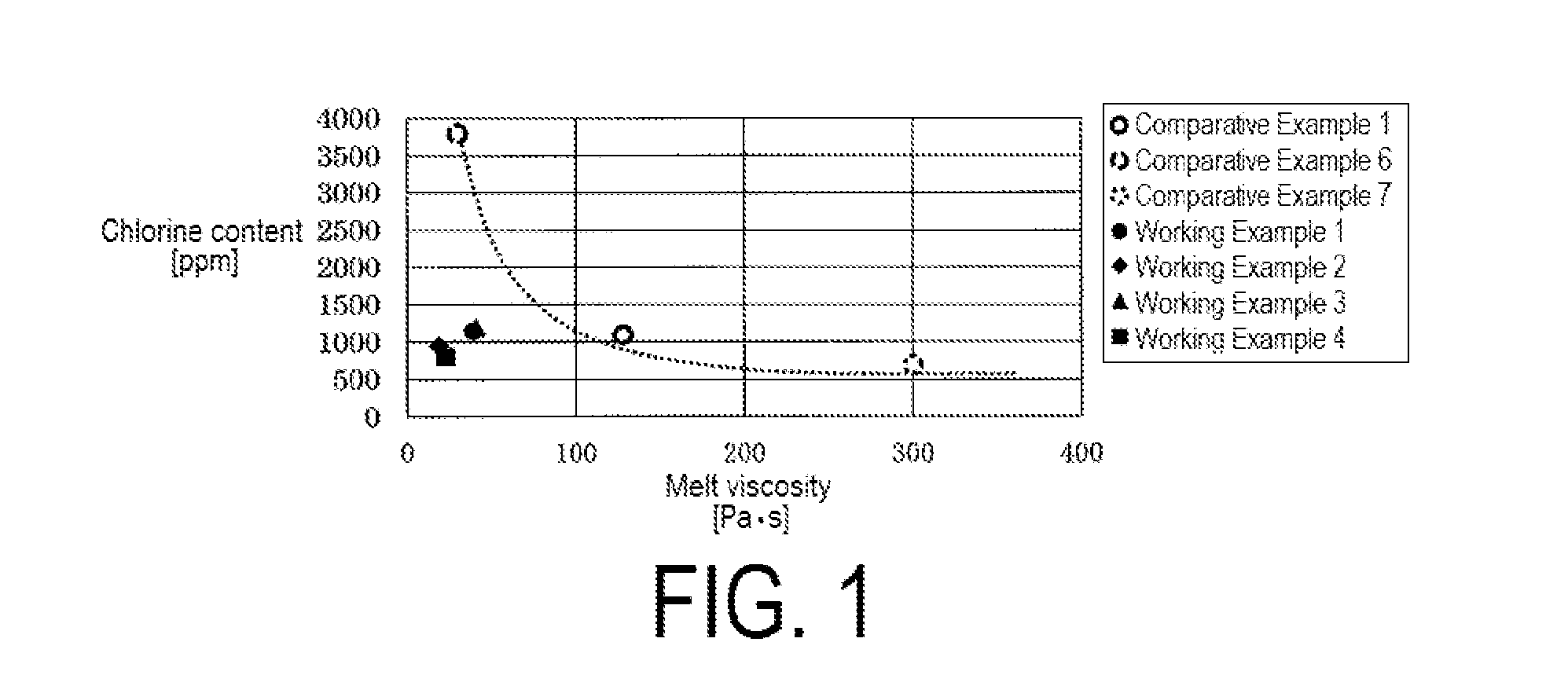Granular polyarylene sulfide and process for manufacturing the same
a technology of polyarylene sulfide and granular polyarylene, which is applied in the field of granular polyarylene sulfide, can solve the problems of poor handling, difficult growth response, and environmental pollution, and achieve the effects of low gas generation, high yield and good thermal stability
- Summary
- Abstract
- Description
- Claims
- Application Information
AI Technical Summary
Benefits of technology
Problems solved by technology
Method used
Image
Examples
working example 1
[0147]First, 6,001 g of N-methyl-2-pyrrolidone (hereafter abbreviated as “NMP”), 2,000 g of a sodium hydrosulfide aqueous solution (NaSH; purity: 62 mass %), and 1,171 g of a sodium hydroxide aqueous solution (NaOH; purity: 74.0 mass %) were charged into a 20-liter autoclave. The molar ratio of NaOH / NaSH (sulfur source) was 0.98.
[0148]As a dehydration step, after the inside of the autoclave was substituted with nitrogen gas, the inside of the autoclave was gradually heated to 200° C. while stirring with a stirrer at a revolution speed of 250 rpm over the course of 4 hours, and 1,014 g of water (H2O), 763 g of NMP, and 12 g of hydrogen sulfide (H2S) were distilled out.
[0149]After the dehydration step described above, the content of the autoclave was cooled to 150° C., and 3,264 g of p-dichlorobenzene (hereafter abbreviated as “p-DCB”), 2,707 g of NMP, 19 g of sodium hydroxide, and 167 g of water were added and reacted for 5 hours at 220° C. while stirring to perform pre-stage polymer...
working example 2
[0153]Operations were performed in the same manner as in Working Example 1 with the exception of adding 14.3 g of DPDS when the p-DCB conversion ratio was 92% at the time of the completion of pre-stage polymerization and setting the molar ratio of DPDS / charged sulfur source to 0.003.
[0154]The average particle size of the granular PAS obtained in this way was 476 μm. In addition, the oversize fraction of the sieve having a mesh size of 150 μm (100 mesh) had a melt viscosity of 19 Pa·s, a chlorine content of 950 ppm, and a nitrogen content of 550 ppm. The oversize fraction of the sieve having a mesh size of 38 μm (400 mesh) had a melt viscosity of 19 Pa·s, a chlorine content of 1,100 ppm, and a nitrogen content of 575 ppm, and the product recovered with filter paper after passing through the sieve having a mesh size of 38 μm (400 mesh) had a melt viscosity of less than 1 Pa·s and a chlorine content of 20,500 ppm. The oversize fraction (mass %) of the granular PAS was 89% in the case o...
working example 3
[0155]Operations were performed in the same manner as in Working Example 1 up to the dehydration step. After the dehydration step, the content of the autoclave was cooled to 150° C., and 3,280 g of p-DCB, 2,708 g of NMP, 19 g of sodium hydroxide, 167 g of water, and 9.5 g of DPDS were added and reacted for 5 hours at 220° C. while stirring to perform pre-stage polymerization. The conversion ratio of p-DCB when DPDS was added (that is, when the polymerization reaction was begun) was 0%. The molar ratio of water / charged sulfur source was 1.50. The molar ratio of NaOH / charged sulfur source was 1.05. The ratio of NMP / charged sulfur source was 0.38 kg / mol. The molar ratio of p-DCB / charged sulfur source was 1.025. The molar ratio of DPDS / charged sulfur source was 0.002. The conversion ratio of p-DCB at the time of the completion of pre-stage polymerization was 92%.
[0156]Next, 443 g of water was pressed into the mixture while stirring was continued, and the mixture was heated to 255° C. an...
PUM
| Property | Measurement | Unit |
|---|---|---|
| Temperature | aaaaa | aaaaa |
| Temperature | aaaaa | aaaaa |
| Temperature | aaaaa | aaaaa |
Abstract
Description
Claims
Application Information
 Login to View More
Login to View More - R&D
- Intellectual Property
- Life Sciences
- Materials
- Tech Scout
- Unparalleled Data Quality
- Higher Quality Content
- 60% Fewer Hallucinations
Browse by: Latest US Patents, China's latest patents, Technical Efficacy Thesaurus, Application Domain, Technology Topic, Popular Technical Reports.
© 2025 PatSnap. All rights reserved.Legal|Privacy policy|Modern Slavery Act Transparency Statement|Sitemap|About US| Contact US: help@patsnap.com

